COIT20263 - Information Security Management: A Case Study of A4A
VerifiedAdded on 2023/06/15
|6
|1243
|333
Case Study
AI Summary
This case study delves into information security management, specifically focusing on Academics for Academics (A4A). It addresses unethical considerations within the workplace, highlighting non-compliance issues such as partiality towards native students and the misutilization of company property. These actions compromise educational needs and strain client relationships, impeding policy development for data security. The document references various sources to support its analysis of information security risk management, employee compliance, and the challenges of implementing effective security measures in academic environments. The study emphasizes the importance of ethical conduct and robust security protocols to safeguard student futures and maintain organizational integrity. Desklib offers a variety of solved assignments and study tools.
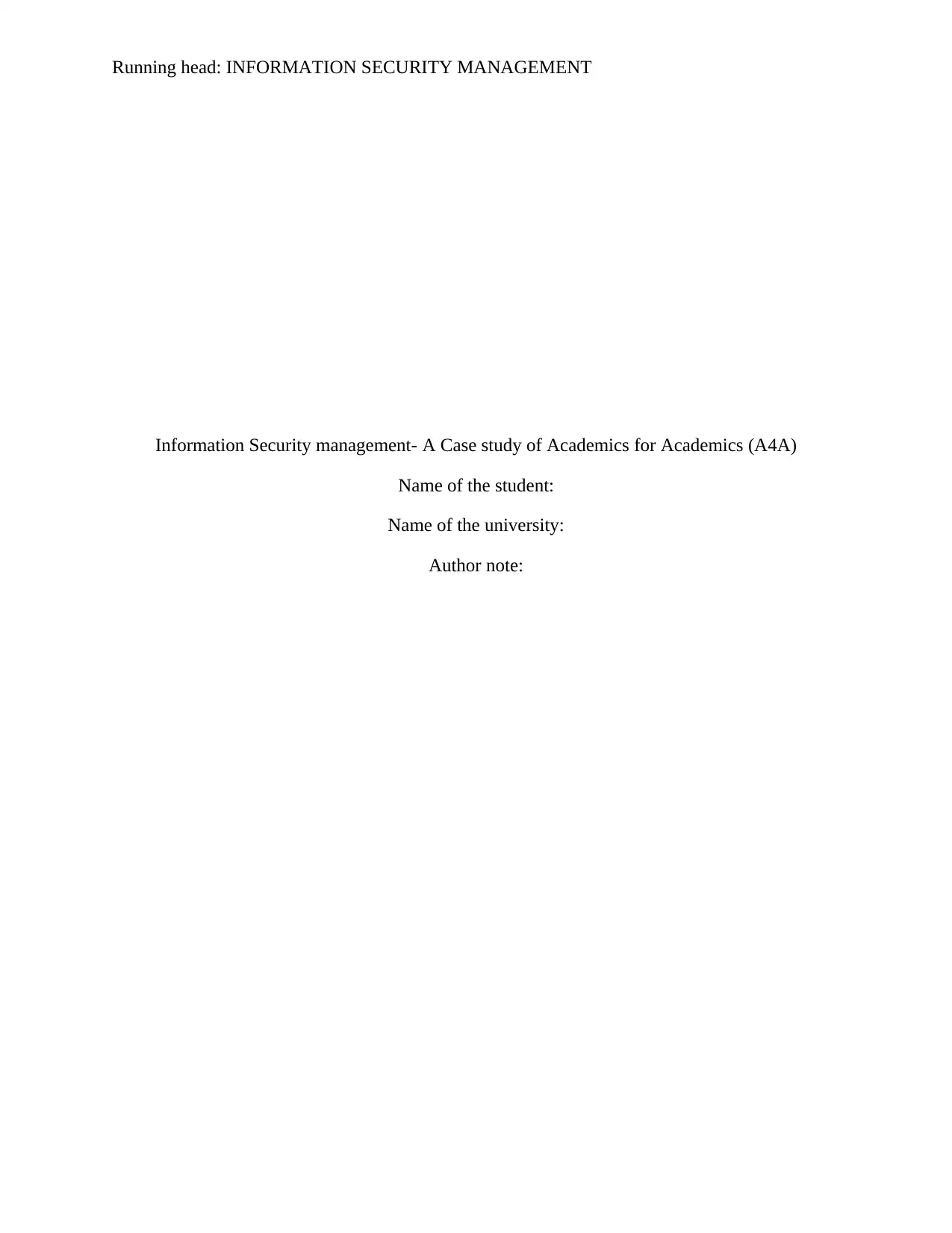
Running head: INFORMATION SECURITY MANAGEMENT
Information Security management- A Case study of Academics for Academics (A4A)
Name of the student:
Name of the university:
Author note:
Information Security management- A Case study of Academics for Academics (A4A)
Name of the student:
Name of the university:
Author note:
Paraphrase This Document
Need a fresh take? Get an instant paraphrase of this document with our AI Paraphraser
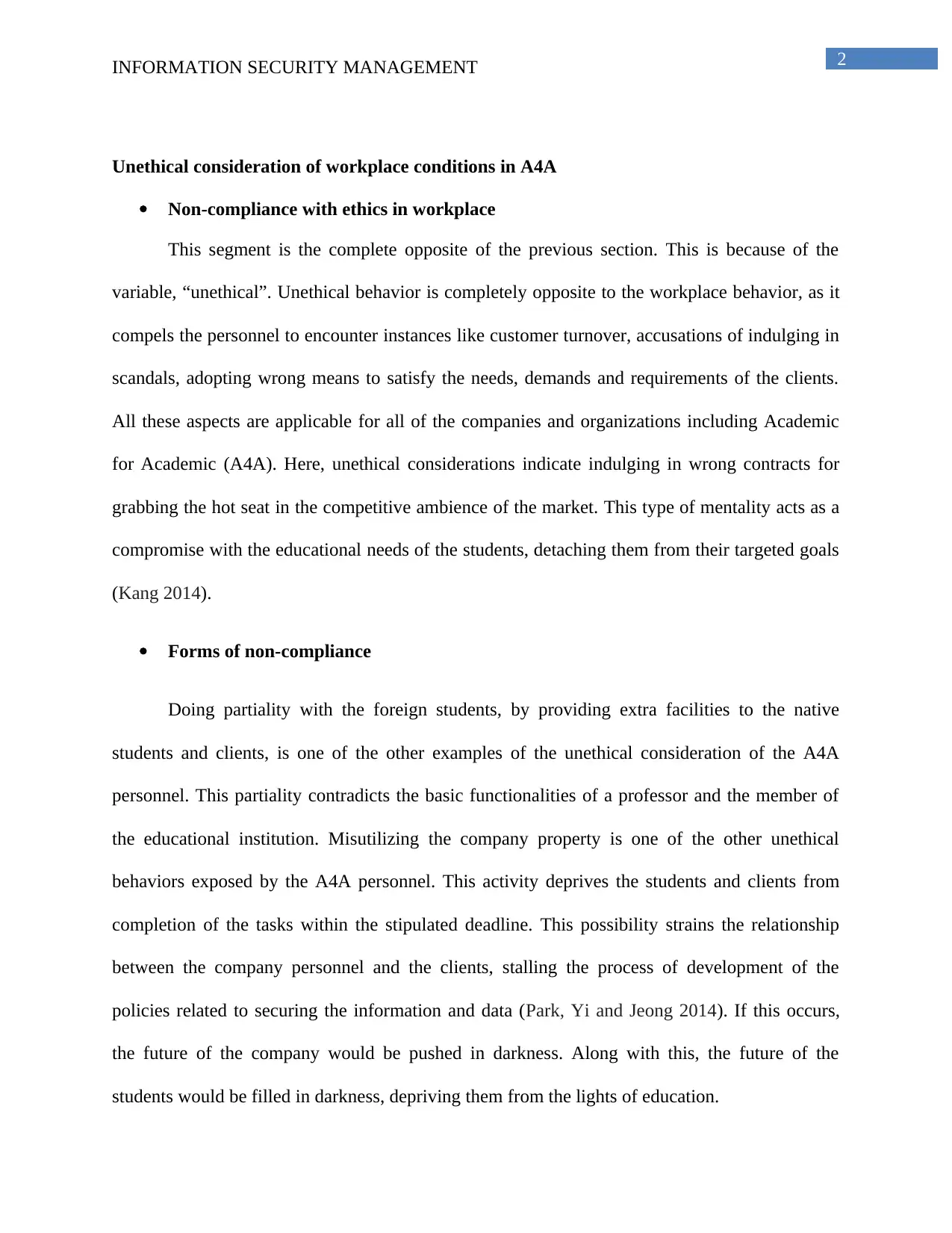
2INFORMATION SECURITY MANAGEMENT
Unethical consideration of workplace conditions in A4A
Non-compliance with ethics in workplace
This segment is the complete opposite of the previous section. This is because of the
variable, “unethical”. Unethical behavior is completely opposite to the workplace behavior, as it
compels the personnel to encounter instances like customer turnover, accusations of indulging in
scandals, adopting wrong means to satisfy the needs, demands and requirements of the clients.
All these aspects are applicable for all of the companies and organizations including Academic
for Academic (A4A). Here, unethical considerations indicate indulging in wrong contracts for
grabbing the hot seat in the competitive ambience of the market. This type of mentality acts as a
compromise with the educational needs of the students, detaching them from their targeted goals
(Kang 2014).
Forms of non-compliance
Doing partiality with the foreign students, by providing extra facilities to the native
students and clients, is one of the other examples of the unethical consideration of the A4A
personnel. This partiality contradicts the basic functionalities of a professor and the member of
the educational institution. Misutilizing the company property is one of the other unethical
behaviors exposed by the A4A personnel. This activity deprives the students and clients from
completion of the tasks within the stipulated deadline. This possibility strains the relationship
between the company personnel and the clients, stalling the process of development of the
policies related to securing the information and data (Park, Yi and Jeong 2014). If this occurs,
the future of the company would be pushed in darkness. Along with this, the future of the
students would be filled in darkness, depriving them from the lights of education.
Unethical consideration of workplace conditions in A4A
Non-compliance with ethics in workplace
This segment is the complete opposite of the previous section. This is because of the
variable, “unethical”. Unethical behavior is completely opposite to the workplace behavior, as it
compels the personnel to encounter instances like customer turnover, accusations of indulging in
scandals, adopting wrong means to satisfy the needs, demands and requirements of the clients.
All these aspects are applicable for all of the companies and organizations including Academic
for Academic (A4A). Here, unethical considerations indicate indulging in wrong contracts for
grabbing the hot seat in the competitive ambience of the market. This type of mentality acts as a
compromise with the educational needs of the students, detaching them from their targeted goals
(Kang 2014).
Forms of non-compliance
Doing partiality with the foreign students, by providing extra facilities to the native
students and clients, is one of the other examples of the unethical consideration of the A4A
personnel. This partiality contradicts the basic functionalities of a professor and the member of
the educational institution. Misutilizing the company property is one of the other unethical
behaviors exposed by the A4A personnel. This activity deprives the students and clients from
completion of the tasks within the stipulated deadline. This possibility strains the relationship
between the company personnel and the clients, stalling the process of development of the
policies related to securing the information and data (Park, Yi and Jeong 2014). If this occurs,
the future of the company would be pushed in darkness. Along with this, the future of the
students would be filled in darkness, depriving them from the lights of education.
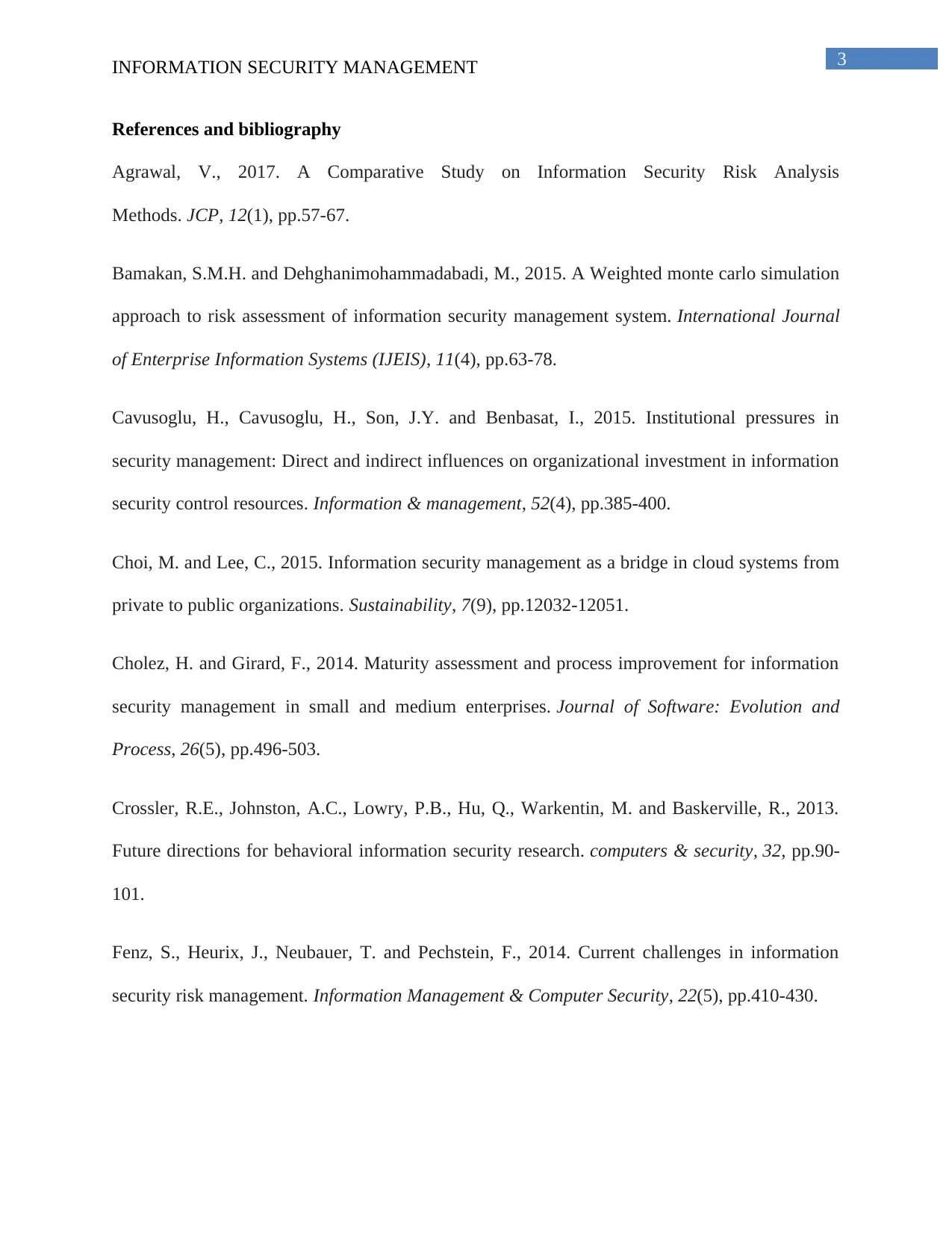
3INFORMATION SECURITY MANAGEMENT
References and bibliography
Agrawal, V., 2017. A Comparative Study on Information Security Risk Analysis
Methods. JCP, 12(1), pp.57-67.
Bamakan, S.M.H. and Dehghanimohammadabadi, M., 2015. A Weighted monte carlo simulation
approach to risk assessment of information security management system. International Journal
of Enterprise Information Systems (IJEIS), 11(4), pp.63-78.
Cavusoglu, H., Cavusoglu, H., Son, J.Y. and Benbasat, I., 2015. Institutional pressures in
security management: Direct and indirect influences on organizational investment in information
security control resources. Information & management, 52(4), pp.385-400.
Choi, M. and Lee, C., 2015. Information security management as a bridge in cloud systems from
private to public organizations. Sustainability, 7(9), pp.12032-12051.
Cholez, H. and Girard, F., 2014. Maturity assessment and process improvement for information
security management in small and medium enterprises. Journal of Software: Evolution and
Process, 26(5), pp.496-503.
Crossler, R.E., Johnston, A.C., Lowry, P.B., Hu, Q., Warkentin, M. and Baskerville, R., 2013.
Future directions for behavioral information security research. computers & security, 32, pp.90-
101.
Fenz, S., Heurix, J., Neubauer, T. and Pechstein, F., 2014. Current challenges in information
security risk management. Information Management & Computer Security, 22(5), pp.410-430.
References and bibliography
Agrawal, V., 2017. A Comparative Study on Information Security Risk Analysis
Methods. JCP, 12(1), pp.57-67.
Bamakan, S.M.H. and Dehghanimohammadabadi, M., 2015. A Weighted monte carlo simulation
approach to risk assessment of information security management system. International Journal
of Enterprise Information Systems (IJEIS), 11(4), pp.63-78.
Cavusoglu, H., Cavusoglu, H., Son, J.Y. and Benbasat, I., 2015. Institutional pressures in
security management: Direct and indirect influences on organizational investment in information
security control resources. Information & management, 52(4), pp.385-400.
Choi, M. and Lee, C., 2015. Information security management as a bridge in cloud systems from
private to public organizations. Sustainability, 7(9), pp.12032-12051.
Cholez, H. and Girard, F., 2014. Maturity assessment and process improvement for information
security management in small and medium enterprises. Journal of Software: Evolution and
Process, 26(5), pp.496-503.
Crossler, R.E., Johnston, A.C., Lowry, P.B., Hu, Q., Warkentin, M. and Baskerville, R., 2013.
Future directions for behavioral information security research. computers & security, 32, pp.90-
101.
Fenz, S., Heurix, J., Neubauer, T. and Pechstein, F., 2014. Current challenges in information
security risk management. Information Management & Computer Security, 22(5), pp.410-430.
⊘ This is a preview!⊘
Do you want full access?
Subscribe today to unlock all pages.

Trusted by 1+ million students worldwide
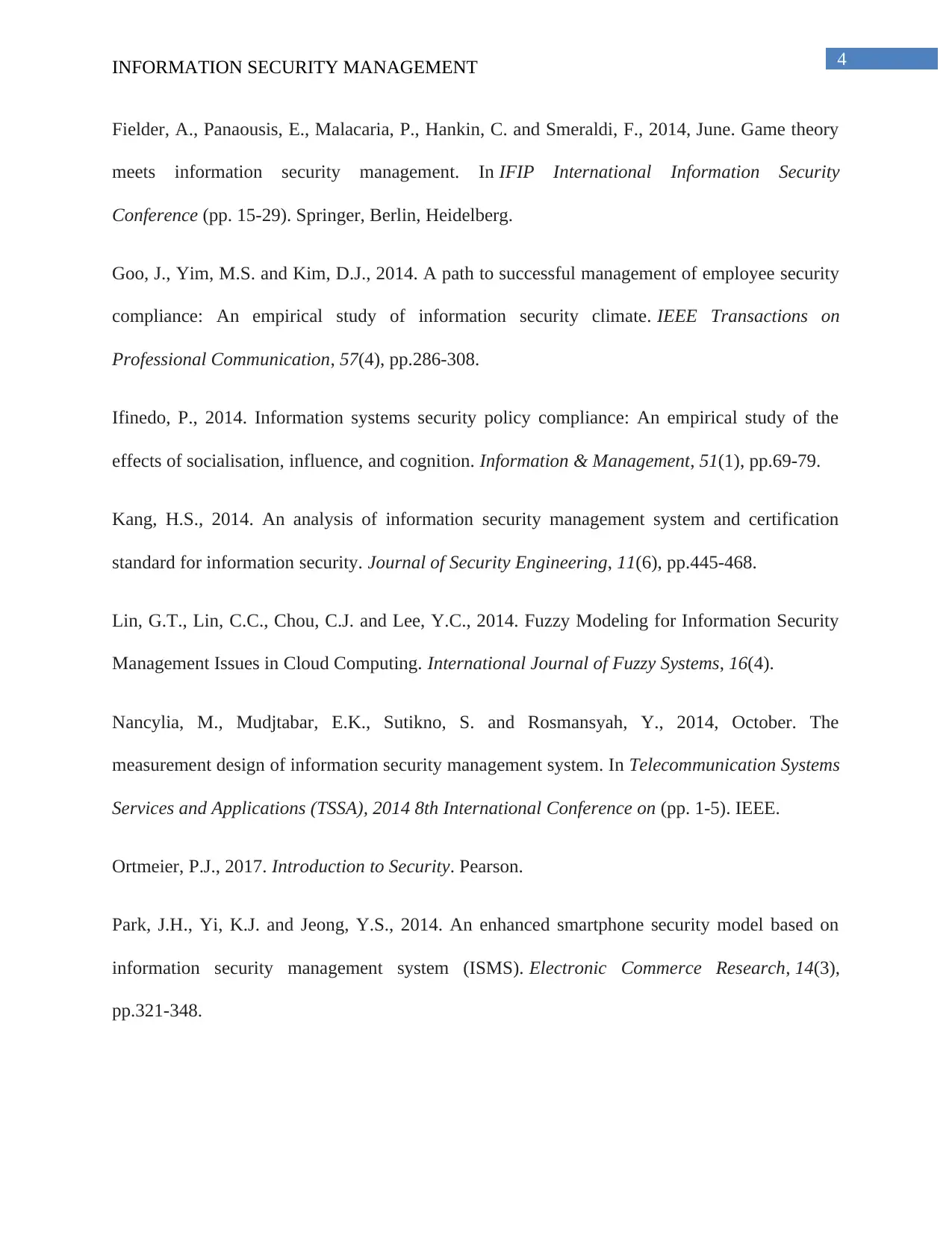
4INFORMATION SECURITY MANAGEMENT
Fielder, A., Panaousis, E., Malacaria, P., Hankin, C. and Smeraldi, F., 2014, June. Game theory
meets information security management. In IFIP International Information Security
Conference (pp. 15-29). Springer, Berlin, Heidelberg.
Goo, J., Yim, M.S. and Kim, D.J., 2014. A path to successful management of employee security
compliance: An empirical study of information security climate. IEEE Transactions on
Professional Communication, 57(4), pp.286-308.
Ifinedo, P., 2014. Information systems security policy compliance: An empirical study of the
effects of socialisation, influence, and cognition. Information & Management, 51(1), pp.69-79.
Kang, H.S., 2014. An analysis of information security management system and certification
standard for information security. Journal of Security Engineering, 11(6), pp.445-468.
Lin, G.T., Lin, C.C., Chou, C.J. and Lee, Y.C., 2014. Fuzzy Modeling for Information Security
Management Issues in Cloud Computing. International Journal of Fuzzy Systems, 16(4).
Nancylia, M., Mudjtabar, E.K., Sutikno, S. and Rosmansyah, Y., 2014, October. The
measurement design of information security management system. In Telecommunication Systems
Services and Applications (TSSA), 2014 8th International Conference on (pp. 1-5). IEEE.
Ortmeier, P.J., 2017. Introduction to Security. Pearson.
Park, J.H., Yi, K.J. and Jeong, Y.S., 2014. An enhanced smartphone security model based on
information security management system (ISMS). Electronic Commerce Research, 14(3),
pp.321-348.
Fielder, A., Panaousis, E., Malacaria, P., Hankin, C. and Smeraldi, F., 2014, June. Game theory
meets information security management. In IFIP International Information Security
Conference (pp. 15-29). Springer, Berlin, Heidelberg.
Goo, J., Yim, M.S. and Kim, D.J., 2014. A path to successful management of employee security
compliance: An empirical study of information security climate. IEEE Transactions on
Professional Communication, 57(4), pp.286-308.
Ifinedo, P., 2014. Information systems security policy compliance: An empirical study of the
effects of socialisation, influence, and cognition. Information & Management, 51(1), pp.69-79.
Kang, H.S., 2014. An analysis of information security management system and certification
standard for information security. Journal of Security Engineering, 11(6), pp.445-468.
Lin, G.T., Lin, C.C., Chou, C.J. and Lee, Y.C., 2014. Fuzzy Modeling for Information Security
Management Issues in Cloud Computing. International Journal of Fuzzy Systems, 16(4).
Nancylia, M., Mudjtabar, E.K., Sutikno, S. and Rosmansyah, Y., 2014, October. The
measurement design of information security management system. In Telecommunication Systems
Services and Applications (TSSA), 2014 8th International Conference on (pp. 1-5). IEEE.
Ortmeier, P.J., 2017. Introduction to Security. Pearson.
Park, J.H., Yi, K.J. and Jeong, Y.S., 2014. An enhanced smartphone security model based on
information security management system (ISMS). Electronic Commerce Research, 14(3),
pp.321-348.
Paraphrase This Document
Need a fresh take? Get an instant paraphrase of this document with our AI Paraphraser
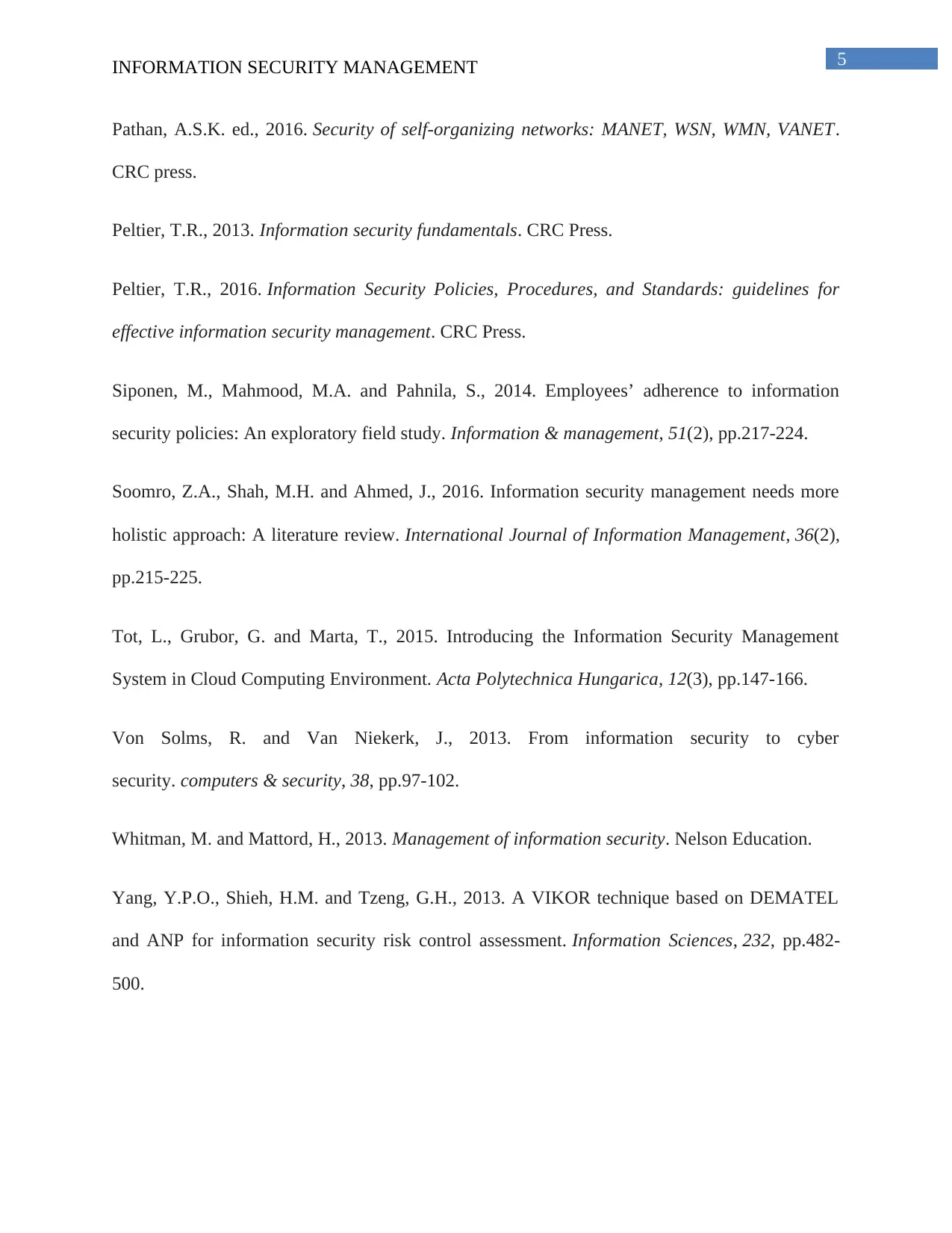
5INFORMATION SECURITY MANAGEMENT
Pathan, A.S.K. ed., 2016. Security of self-organizing networks: MANET, WSN, WMN, VANET.
CRC press.
Peltier, T.R., 2013. Information security fundamentals. CRC Press.
Peltier, T.R., 2016. Information Security Policies, Procedures, and Standards: guidelines for
effective information security management. CRC Press.
Siponen, M., Mahmood, M.A. and Pahnila, S., 2014. Employees’ adherence to information
security policies: An exploratory field study. Information & management, 51(2), pp.217-224.
Soomro, Z.A., Shah, M.H. and Ahmed, J., 2016. Information security management needs more
holistic approach: A literature review. International Journal of Information Management, 36(2),
pp.215-225.
Tot, L., Grubor, G. and Marta, T., 2015. Introducing the Information Security Management
System in Cloud Computing Environment. Acta Polytechnica Hungarica, 12(3), pp.147-166.
Von Solms, R. and Van Niekerk, J., 2013. From information security to cyber
security. computers & security, 38, pp.97-102.
Whitman, M. and Mattord, H., 2013. Management of information security. Nelson Education.
Yang, Y.P.O., Shieh, H.M. and Tzeng, G.H., 2013. A VIKOR technique based on DEMATEL
and ANP for information security risk control assessment. Information Sciences, 232, pp.482-
500.
Pathan, A.S.K. ed., 2016. Security of self-organizing networks: MANET, WSN, WMN, VANET.
CRC press.
Peltier, T.R., 2013. Information security fundamentals. CRC Press.
Peltier, T.R., 2016. Information Security Policies, Procedures, and Standards: guidelines for
effective information security management. CRC Press.
Siponen, M., Mahmood, M.A. and Pahnila, S., 2014. Employees’ adherence to information
security policies: An exploratory field study. Information & management, 51(2), pp.217-224.
Soomro, Z.A., Shah, M.H. and Ahmed, J., 2016. Information security management needs more
holistic approach: A literature review. International Journal of Information Management, 36(2),
pp.215-225.
Tot, L., Grubor, G. and Marta, T., 2015. Introducing the Information Security Management
System in Cloud Computing Environment. Acta Polytechnica Hungarica, 12(3), pp.147-166.
Von Solms, R. and Van Niekerk, J., 2013. From information security to cyber
security. computers & security, 38, pp.97-102.
Whitman, M. and Mattord, H., 2013. Management of information security. Nelson Education.
Yang, Y.P.O., Shieh, H.M. and Tzeng, G.H., 2013. A VIKOR technique based on DEMATEL
and ANP for information security risk control assessment. Information Sciences, 232, pp.482-
500.
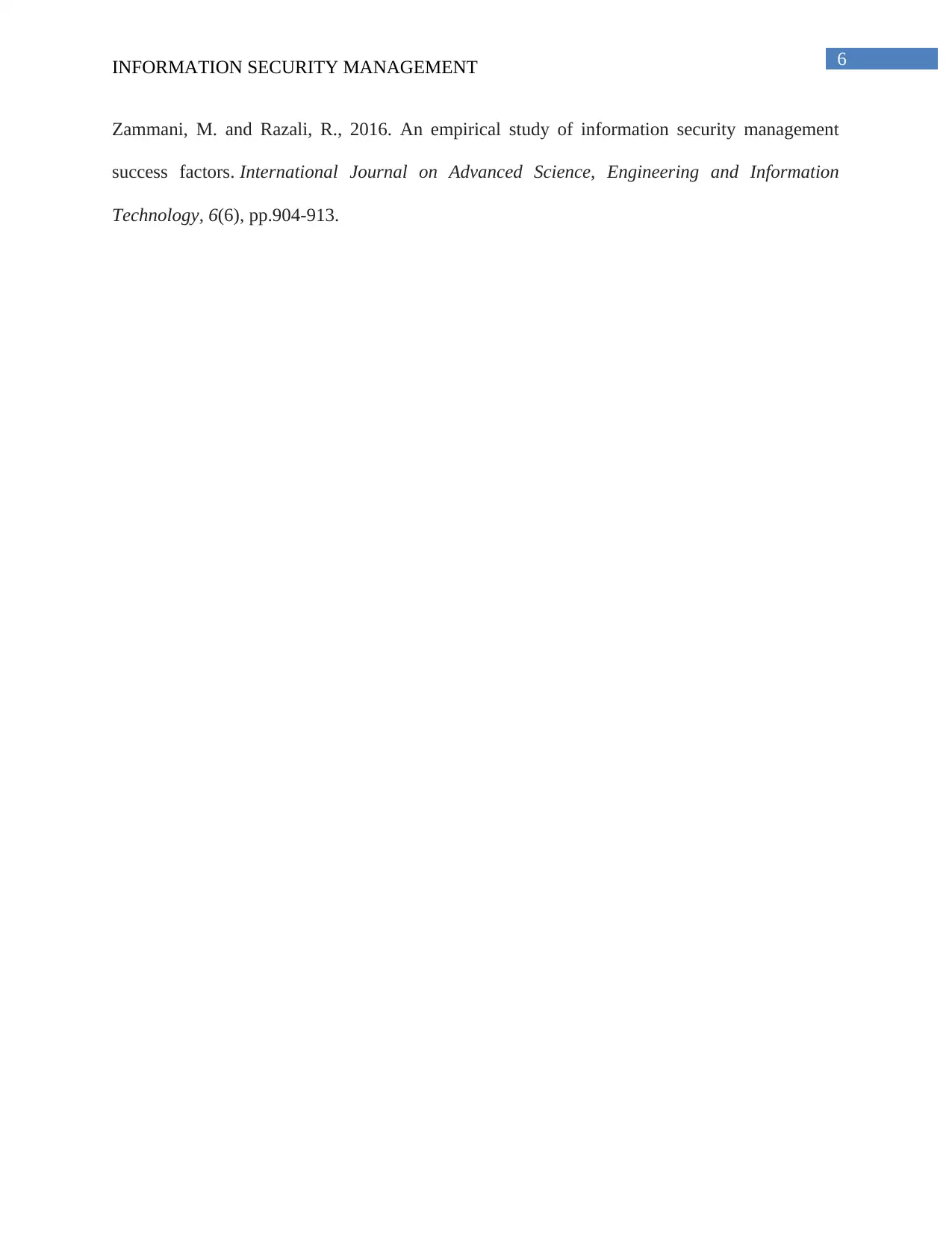
6INFORMATION SECURITY MANAGEMENT
Zammani, M. and Razali, R., 2016. An empirical study of information security management
success factors. International Journal on Advanced Science, Engineering and Information
Technology, 6(6), pp.904-913.
Zammani, M. and Razali, R., 2016. An empirical study of information security management
success factors. International Journal on Advanced Science, Engineering and Information
Technology, 6(6), pp.904-913.
⊘ This is a preview!⊘
Do you want full access?
Subscribe today to unlock all pages.

Trusted by 1+ million students worldwide
1 out of 6
Your All-in-One AI-Powered Toolkit for Academic Success.
+13062052269
info@desklib.com
Available 24*7 on WhatsApp / Email
![[object Object]](/_next/static/media/star-bottom.7253800d.svg)
Unlock your academic potential
Copyright © 2020–2025 A2Z Services. All Rights Reserved. Developed and managed by ZUCOL.
